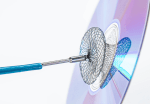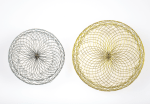Severe persistent calcification of the coronary arteries has been associated with different factors, such as advanced age, hypertension, dyslipidemia, smoking, and kidney failure, among others, and continues to be one of the challenges to stent implantation because of it impact on device advancing, drug release and adequate positioning. Intravascular lithotripsy (IVL) is a technique that...
Lithotripsy in the Left Main Coronary Artery
A lesion ≥50% in the left main coronary artery (LMCA) is considered severe, according to various scientific societies, regardless of the presence of symptoms or ischemia, due to the extent of myocardium at risk. In such cases, revascularization is indicated. In many patients, lesions in this section of the coronary artery have severe calcification, which...
Should We Use Ultrasound Routinely to Guide Transfemoral Access?
Currently, transfemoral access (TFA) is used in large-caliber procedures and when transradial access fails. The introduction of ultrasound (US) to guide access has emerged as a technique that allows for precise channeling, avoiding accesses above or below the inguinal ligament. However, evidence regarding the use of this tool has shown diverse results. Two surveys conducted...
Left Atrial Appendage Closure and Concomitant Transcatheter Intervention: Can We?
Several scientific societies support performing left atrial appendage occlusion (LAAO) as a stand-alone procedure, even though it is often associated to other cardiomyopathies requiring transcatheter intervention. Though still controversial, combining LAAO and any other cardiac intervention might reduce hospitalizations, as well as the need for additional punctures, anesthesia, red tape, a longer stay and higher...
TAVR: High Implantation of Self-Expanding Valves Directly Impacts ECG
TAVR has been shown beneficial, especially in high risk or inoperable patients. However, there are limitations to its use, especially with self-expanding valves, which are the need for pacemaker implantation and ECG changes after procedure. To address this matter, researchers assessed the right and left cusp overlap effect on 254 patients undergoing TAVR with self-expanding...
Is TAVR Beneficial in Cardiogenic Shock?
The presence of cardiogenic shock (CS) in a setting of aortic stenosis ranges from 1% to 4%. The prognosis for this scenario is ominous due to subendocardial ischemia, which presents as a decrease in ventricular preload and an increase in afterload. Aortic valvuloplasty has been used in this context, but, unfortunately, it has been associated...
Ultrathin Stents Shown Safe and Effective in Real World Patients
Ultrathin drug eluting stents (60 µm) had been shown beneficial vs. thin-strut stents in terms of target lesion failure (TLF) at 2, 3 and 5 years in randomized studies, but they had not been yet assessed in “real world” patients. The BIOFLOW VII is a prospective, multicenter study including 556 “real world”patients with a total...
Should We Use Ultrasound to Guide Transfemoral Access Routinely?
Currently, transfemoral access (TFA) is used in large-caliber procedures and when transradial access is not successful. The use of ultrasound (US) to guide access has emerged as a technique that allows for precise cannulation, avoiding accesses above and below the inguinal ligament. However, evidence regarding the effectiveness of this tool has shown variable results. Two...
Left Atrial Appendage Closure: As Effective in Men and Women?
Atrial fibrillation is the most prevalent arrhythmia and to prevent its potential complications, we should administer anticoagulants (OACs), either warfarin or the new direct oral anticoagulants (DOACs). Even though these drugs have been shown effective, they still involve the risk of bleeding, especially gastrointestinal bleeding, which in turn leads to numerous hospitalizations. Left atrial appendage occlusion...
Transcatheter Mitral Valve Replacement vs. Medical Therapy
Mitral valve regurgitation (MR) is a common cause behind heart failure and is associated to hospitalization for heart failure and higher mortality. Transcatheter edge-to-edge repair (TEER), together with guideline-directed medical therapy (GDMT) has been shown beneficial in high risk patients, according to the COAPT study. However, there is a significant group of patients that make...









